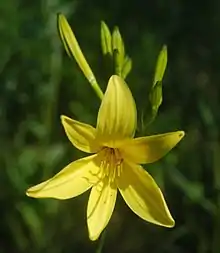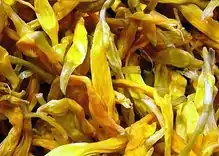| Lemon daylily | |
|---|---|
 | |
| Scientific classification | |
| Kingdom: | Plantae |
| Clade: | Tracheophytes |
| Clade: | Angiosperms |
| Clade: | Monocots |
| Order: | Asparagales |
| Family: | Asphodelaceae |
| Subfamily: | Hemerocallidoideae |
| Genus: | Hemerocallis |
| Species: | H. lilioasphodelus |
| Binomial name | |
| Hemerocallis lilioasphodelus | |
Hemerocallis lilioasphodelus (syn. Hemerocallis flava, known as lemon daylily, lemon lily, yellow daylily, and other names) is a plant of the genus Hemerocallis. It is found across China, in Europe in N.E. Italy and Slovenia and is one of the first daylilies used for breeding new daylily cultivars.[1]
Hemerocallis lilioasphodelus grows in big, spreading clumps, and its leaves grow to 75 cm (30 in) long. Its scapes each bear from 3 through 9 sweetly fragrant, lemon-yellow flowers.[1]
Culinary use
The flowers of some daylillies, including Hemerocallis lilioasphodelus are edible[2] and are used in Chinese and Japanese cuisine.
Gallery
 Hemerocallis lilioasphodelus
Hemerocallis lilioasphodelus Hemerocallis lilioasphodelus
Hemerocallis lilioasphodelus Dried golden needles
Dried golden needles_spectral_comparison_Vis_UV_IR.jpg.webp) Comparison showing flower in visible light, ultraviolet, and infrared. Note the nectar guide pattern visible in UV
Comparison showing flower in visible light, ultraviolet, and infrared. Note the nectar guide pattern visible in UV Hemerocallis lilioasphodelus Stamen under the microscope. Magnification x9
Hemerocallis lilioasphodelus Stamen under the microscope. Magnification x9
References
Wikimedia Commons has media related to Hemerocallis lilioasphodelus.
- 1 2 Botanica : the illustrated A-Z of over 10,000 garden plants and how to cultivate them., Köln: Könemann, 2004, p. 440, ISBN 978-3-8331-1253-9
- ↑ Niering, William A.; Olmstead, Nancy C. (1985) [1979]. The Audubon Society Field Guide to North American Wildflowers, Eastern Region. Knopf. p. 600. ISBN 0-394-50432-1.
This article is issued from Wikipedia. The text is licensed under Creative Commons - Attribution - Sharealike. Additional terms may apply for the media files.